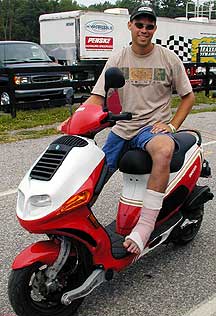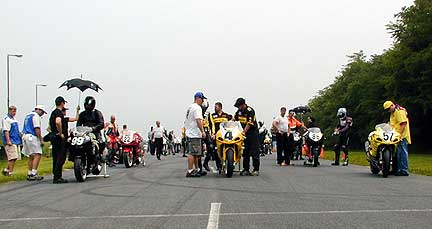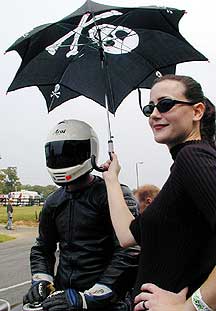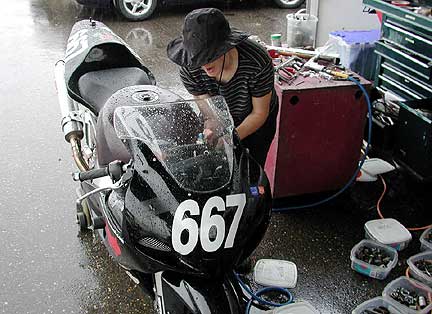2001 – Part Five
Summit Point Raceway
Summit Point, West Virginia
August 4, 2001
After the Portland round and its related travel time, crash damage and emergency rider substitution we were all looking forward to the Summit round, its short travel time from DC and the return of an uninjured Brian Stokes to our rider roster.
The best laid plans of mice and men often go astray.
Shibboleths are words or phrases that are used within a group or clique to help define that group. One of our crueler shibboleths is "groundhog bike". Taking its root from the premise of the movie "Groundhog Day" it is used to describe a slowish rider or bike that you seem to be passing over and over and over again. Groundhog bikes are also noteworthy because when you mention one (i.e. – "that blue GSX-R groundhog bike") everyone in the pits knows to which bike you are referring. Groundhog bikes are much more noticeable in endurance races because you can actually lap someone five or 10 times in a stint.
On this fateful Friday practice there was a groundhog bike out in the expert practice piloted by someone whose admirable enthusiasm for entrance speed was undaunted by his lack of understanding of the track’s design. This combination led to lots of last-minute line changes. Most of us had spotted this unpredictable combination early in the session but it was Brian Stokes’ misfortune to startle this rider with an outside pass. Our groundhog straightened up out of the turn, target fixated on, of all things, Brian’s foot and torpedoed Brian with a front wheel into the footpeg. A straight-up T-bone. Brian crashed and was unhurt save for his crushed foot. He had a total of about two hours of post-injury riding before being sidelined again.

Grounded Stokes.
Photo by AOD Ministry of Information.
Our hearts collectively sank. However, Summit was one of the five events for the AMA-exiled Pro-Thunder racers. This implied that our stand-in teammate from the Portland round, Jeff Nash, was at the track and eager to get a few more laps around Summit’s challenging layout before his sprint race on Sunday. Egged on by the fact that his Pro-Thunder rival, Tripp Nobles, would be riding another GSX-R in the Endurance race, Nash was successfully coerced into riding with AOD again.
Whereas a blown motor on his GSX-R would ultimately betray Nobles, the AOD bike performed flawlessly. Jim, Jeff and I rode fast and consistent but were unable to catch the three GSX-R1000s clogging up the podium. At the start of the third hour we were on the same lap as Ridge Racing when a light rain began to fall. This was exactly the chance we had been waiting for. We pulled out the rain tires and waited for the track to become thoroughly soaked. Our strategy was to pit, swap to rains and proceed to run about 10 seconds a lap faster than anyone remaining on DOTs. We also figured that most other teams could not switch rims as quickly as the AOD crew so the switch to rains would get us 60 seconds to 120 seconds on the two teams leading us in the race and we could claim third, if not second, place on the overall podium.

It looks like pole, but it is actually third place.
Photo by AOD Ministry of Information.
The West Virginia weather had other plans and, just as we were laying out the air wrenches and breaking out the "pit in" board, a lightning-induced red flag was displayed and the clock started ticking. We needed the lightning to stop and for race control to restart the race within 20 minutes or we would reach the 30-minutes-remaining mark which would end the race. WERA endurance races are not restarted if less than 30 minutes remains on the clock. Just 15 minutes later the pit stewards announced that the race was called and it would end, not with a bang, but with a whimper. Our result, first 600cc, fourth overall.

Scott is pampered on the starting grid at
Summit Point. Photo by AOD
Ministry of Information.
Memphis Motorsports Park
Millington, Tennessee
September 1, 2001
To break up the racing season Melissa and I went for a 14-day, 300-mile canoe trip in the wilds of the Canadian Yukon featuring Class III whitewater, float planes, 34-degree mornings and grizzly bears.

Picking a line. Photo by Peggy Fleming.
Returning to civilization we learned that the Rausch Creek round had been rescheduled to VIR due to the fact that VIR had pavement and Rausch Creek had mounds of dirt.
For much of the summer we have witnessed various sanctioning bodies face criticism for their reactions to rain. Memphis was WERA’s turn to be placed in the hot seat.
Memphis is a motorsports park which was laid out in the pre-VHT days. As with other tracks of its period, the dragstrip is also used as the front straight. This efficient use of space did not create problems until the drag race guys developed a spray which, when applied to pavement, provides Very High Traction. This allowed for improved ¼-mile times and provided great traction on hot summer days. However, drag racers prefer to stay indoors when it is raining so they were not concerned that VHT become NFT when wet.
For years this had not been a huge problem for the WERA National Endurance series since it had only rained on a couple of WERA Nationals in something like six years. Then it only rained at tracks which were raceable in the wet for a couple more years. And then, in 2001, it rained at Memphis.
We were, once again, all watching the weather map. A huge system had built up in the south and Memphis was right on the northern edge. It could have gone either way but on Friday morning it was a steady drizzle. We mounted up the rains and went out to get comfortable. What we, and every other rider found, was that the front straight was impassable except for 18 inches next to the inside pit wall. Then that clean line ran out and wheel spin was unavoidable with an open throttle. Several sections of the track had streams flowing across them and other turns had the slide-catch-slide-catch feel associated with crossing lines of wet sealant. Probably because there were lines of wet sealant.
Even with rain tires it was treacherous and the front straight was a slow, single-file affair. Did I mention that the outside of the Memphis final turn and front straight is a solid concrete wall?
Various team captains and owners conversed in the pits. The consensus amongst everyone in the running for a Championship (and there were four fierce class Championship points battles) was that we should not run in the wet due to the bad things that happen with racers and concrete walls. This opinion was shared by many with the Race Director.
Saturday dawned with more bad weather. The radar map showed waves of rain and clouds. The track would get wet, then dry, then wet.
Everyone wanted to race. We had all driven hundreds of miles to race. However, no one wanted to see a friend hit the concrete wall. In one of the clear spells a few optimists set to sweeping water off of the track and digging impromptu drainage channels to stem the flow of water across some of the turns. Most of us sat on the pit wall and alternately watched the storm clouds build on the near horizon while suffering the verbal abuse of the optimists.

This side of racing not typically publicized. Photo by Flipper.
The start of the race was delayed to allow additional time to try to dry the track. At the late-morning riders’ meeting tempers were heated. One team, with no stake in the series, wanted to race regardless. Predictably they questioned the commitment of the rest of us who thought racing on the wet, concrete-lined, VHT-coated track was less-than-prudent. WERA officials announced the following: They were going to start the race if the track was dry. They would not start the race if the track was wet. If the race was started on a dry track, and we got a few laps in, and then it rained, it would be called a race. We would be given a 30-minute practice session to assess the condition of the track before the race was flagged off and we would be allowed to offer input after the 30-minute session. We were assured that reservations about the condition of the track would be honored after the 30-minute session.
We went to pick out our tires for the tricky conditions. Our mad scramble to pick tires and get them mounted to bikes was interrupted by another deluge of rain. My satisfaction at having the situation be resolved one way or the other was interrupted by an elderly Canadian spitting vitriol at me for having organized the cancellation of the race. I thought this was entirely inappropriate since I had no say in what WERA officials did or did not do about the weather and, actually, my team had nothing to lose or gain from running or not running. My offers to talk about the situation with the gentleman were angrily rebuked.
Now WERA, which was going to have to eat the track rental and refund all the entry fees, had passed the test. The WERA officials had put rider safety before "the show must go on" mentality.
I didn’t want WERA to lose money on the entry fees and I certainly didn’t want to lose our chance at winning contingency money so we put our heads together in the AOD pits and came up with a plan which would allow the teams to get in all the races and for WERA to recoup its losses from the rain-out. We could do a double-header endurance at VIR three weeks later. Two 3.5-hour races with an hour in between them. One round would be the make-up for Rausch, the second the make-up for Memphis. It would even out the points battles, it would get WERA the entry fees back and it would allow us a shot at the contingency money.
We bounced the idea off of WERA’s Sean Clarke in the pits. He said he would consider it. We then found every team captain of the top 13 teams, gave them the spiel and they marched off to give Sean the thumbs-up.
Then we drove home.
The next day we started a thread on the WERA BBS (www.wera.com) and posted the suggestion to see if everyone still felt the same way. A very funny thing happened which really does illustrate the power of the Internet. Eight or nine people collaborated on the WERA BBS including the perspective of the racers, the big teams, the small teams, the officials, the cornerworkers and the endurance scorers. They thrashed around various schedules debating the pros and cons of each iteration until they arrived on one that made the most sense. It was ultimately WERA’s decision about what the event schedule and content would be but, because many people had been included in the decision-making process, there was 100 percent buy-in from all parties before the final announcement came out. We were not surprised by the result, we could all read the discussion on the BBS to see the debate, and the final rationale for the schedule. It was a perfect open model for how a complex, difficult situation could be handled with everyone feeling satisfied with the result.
There was some fall-out controversy about what WERA should or should not have done with the rain but everyone lost the will to argue about it a week later. A week later was September 11th.
*For 2002 WERA requested that Memphis make several changes to the layout to permit racing in the wet. Memphis declined to commit to make the improvements. WERA has not scheduled a race at Memphis for 2002.
